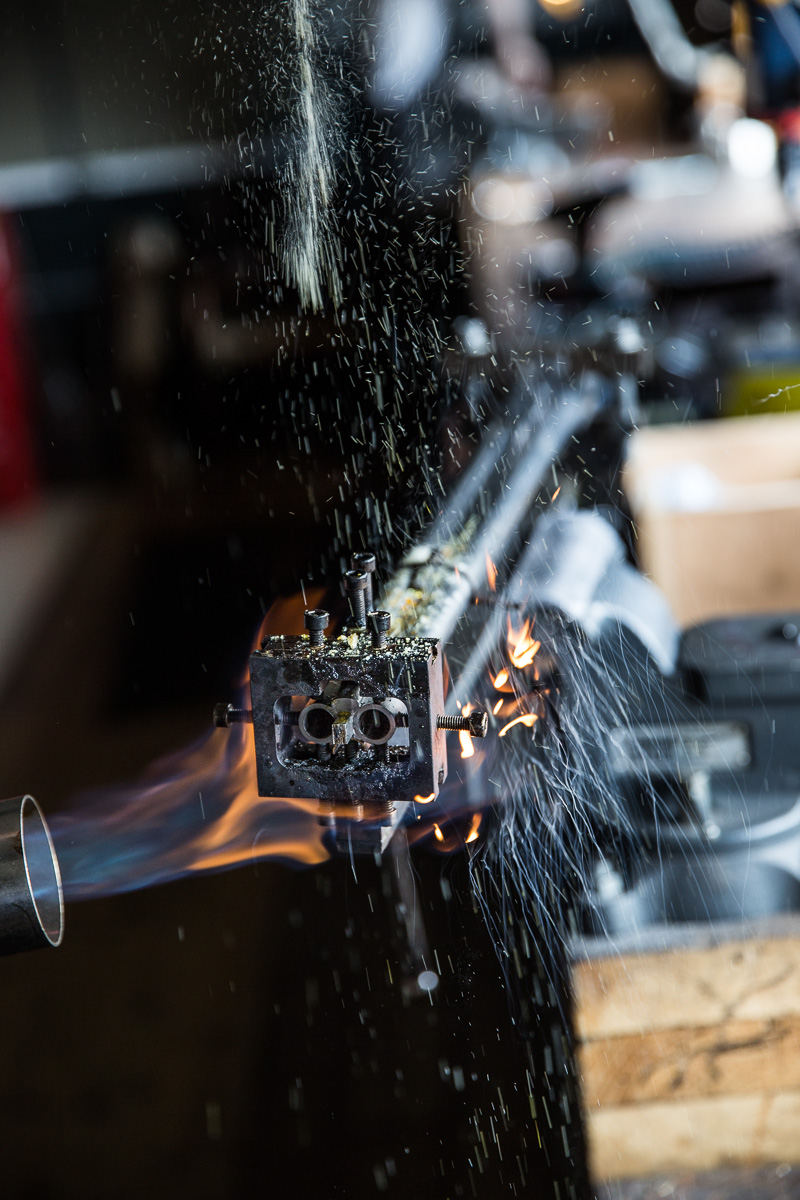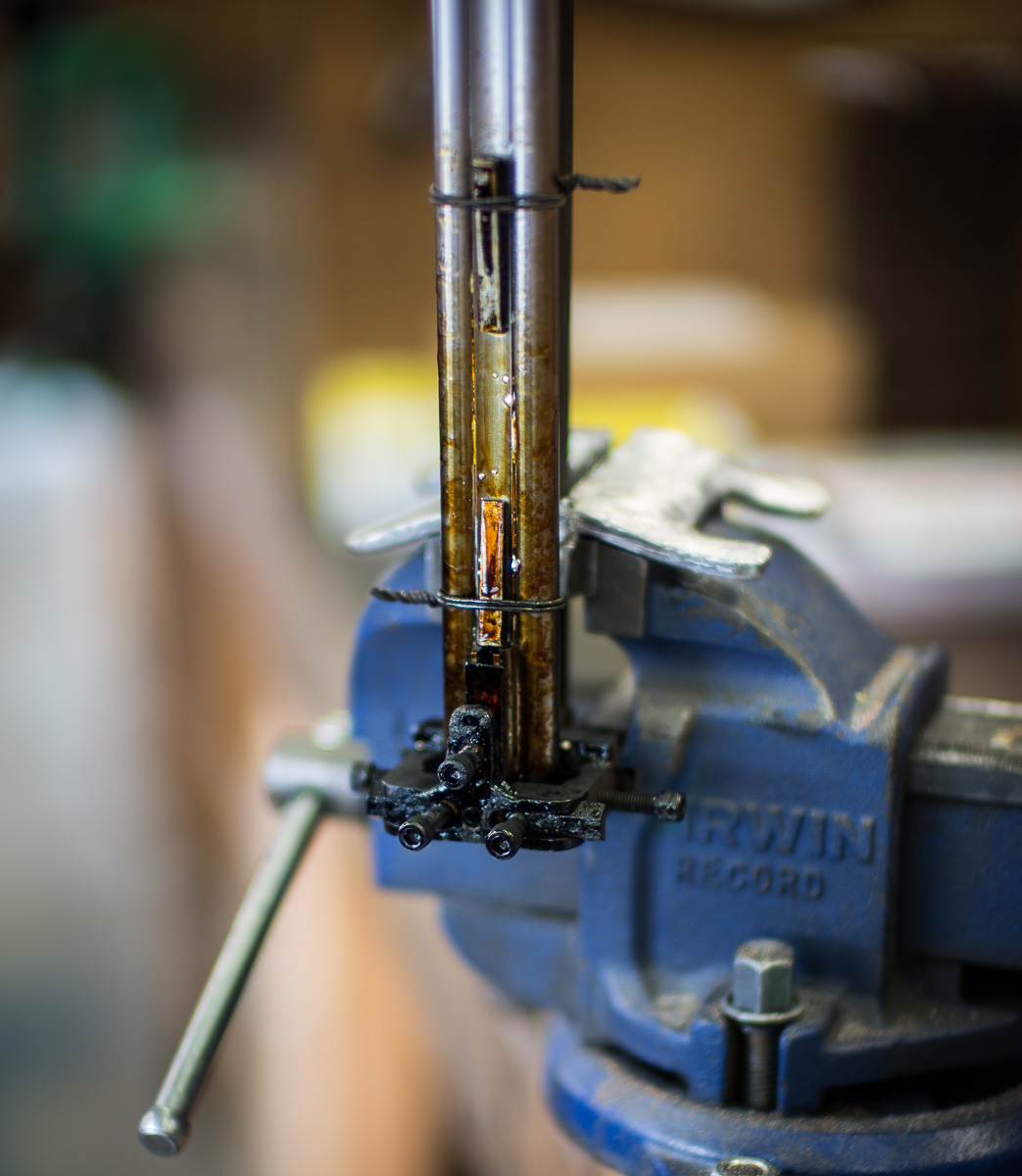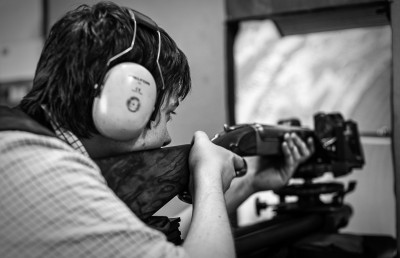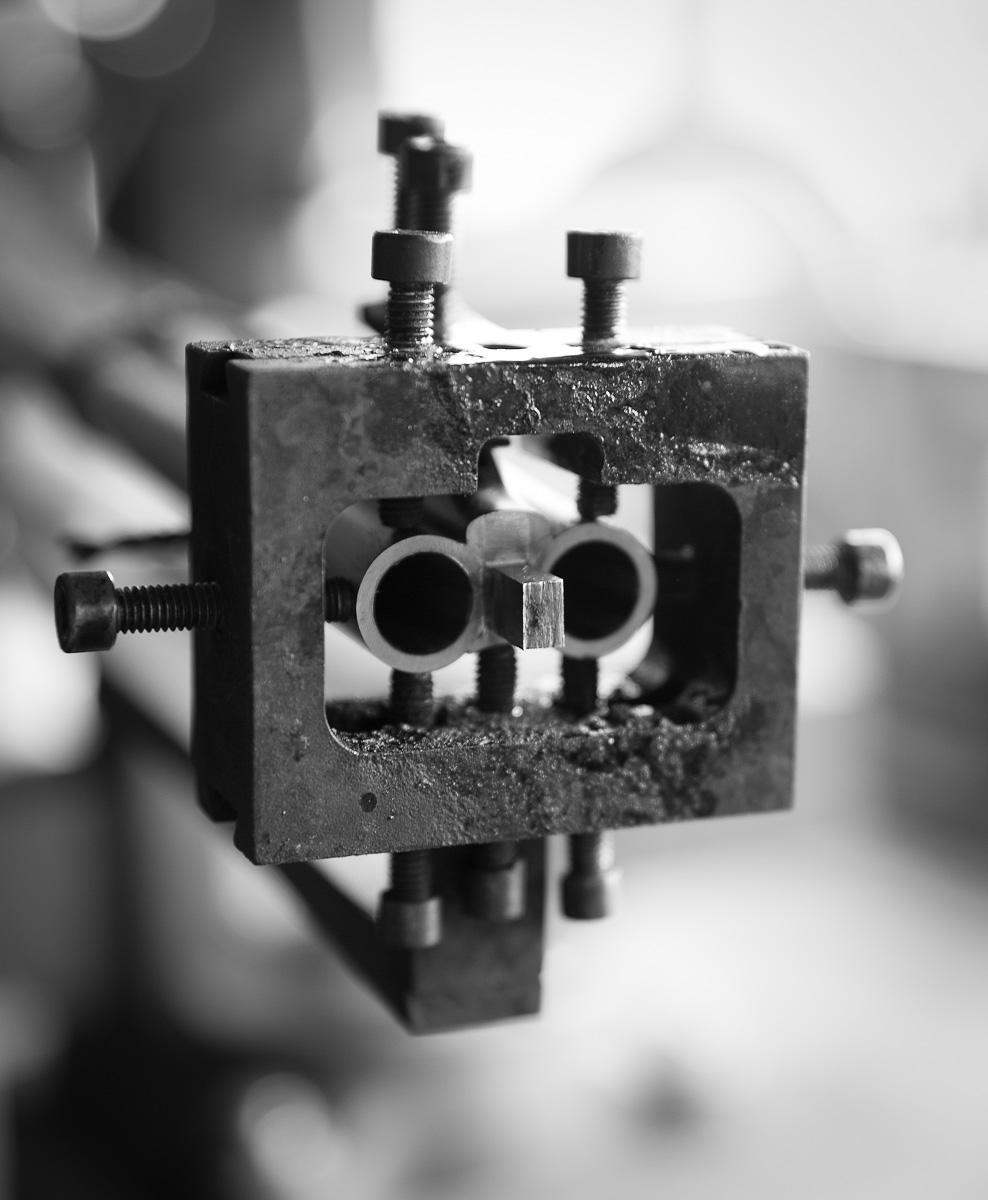Regulating the barrels of a rifle means adjusting/regulating the 2 barrels of a rifle to shoot to the same point of aim at a given distance. This is acheived by a repetitive process of shooting the rifle and then making minute adjustments to individual barrels in a specific jig, ultimately moving the barrels to the correct the point of impact.
At Westley's we shoot our rifles on our range, this is equipped with both a chronograph and an electronic target system. The chronograph measures the individual velocity of each shot, a consistent velocity is required to judge the shots and this way we are able to pick up any 'flyers' meaning low or high velocity shots and these can then be discounted in any adjustments. I would emphasise, that without very consistent loads, regulation is impossible, and this is an area we have invested a considerable amount of time and money on here over the years. The electronic target system provides an accurate history of all the shots taken during the regulation process.
Having shot the rifle with 4 shots to confirm accuracy the rifle is then disassembled, front sight removed and the barrels are placed in a regulating jig as seen above. This jig supports the barrels and allows individual adjustments through the use of 9 hex head bolts. There is a wedge in the muzzle of the rifle which aides in the barrels being drawn either inwards (draw wedge out) and apart (push wedge in).
Having set the barrels firmly in the jig, the muzzle ends are heated up to a point where the solder holding the barrels together begins to melt, at this point the barrels can be independently moved in any direction to obtain the correct convergence and point of aim. This is done by relieving the opposing bolt and tightening the other side. Adjustments are made in small movements of about .0010" a time although this is where the process becomes one of feel and knowledge rather than pure measurement. The barrels are then allowed to cool down completely after which they are cleaned and the process begins again and is repeated until the desired result is achieved.
 Flux is applied to the barrels to keep the solder running freely during heating.
Flux is applied to the barrels to keep the solder running freely during heating.
 Drawing out the wedge in order to move the barrels closer together.
Drawing out the wedge in order to move the barrels closer together.
 Minute adjustments are made in the jig using hex key.
Minute adjustments are made in the jig using hex key.
 The barrels cooling down in jig. The wire wraps are in place to keep the barrels in place.
The barrels cooling down in jig. The wire wraps are in place to keep the barrels in place.
A series of 4 targets showing the movement of the shots after regulating in jig.
 Stuart Richards with another completed rifle.
Stuart Richards with another completed rifle.
I can say without hesitation that in all my years here with the company, the regualtion process has not been done as efficiently and accurately as it is being done now in the careful, young and enthusiastic hands of Stuart Richards who tells me his fastest regulation was in 8 shots and the longest over 100 shots, and also points out that the large calibre's are so much easier than the small ones. I know there is a sincere sense of pride every time he produces a final target which are always exceptional.



 Enquire
Enquire





















Mark bennett on May 21, 2014 at 10:06 pm
Hello there , just a thought about the regulating of a double rifle ,would it be possible to achieve the same result by fitting a low power lasers concentric in the bores and adjusting the barrels when they are heated .
Regards. Mark
Simon Clode on May 21, 2014 at 10:17 pm
Thank you for your comment. The answer from our experience is no, this does not work, we are regulating the rifle to shoot with a specific bullet and load, regulation or point of aim will alter with type of load and type of bullet used. We specify when we deliver the rifle what ammunition and load the rifle is regulated to. We regulate to actual, not theoretical.
Simon
Mark bennett on May 21, 2014 at 10:29 pm
Thank you for your reply ,I do see what you mean .
Mark
paul j. antonino on May 21, 2014 at 11:44 pm
and hope whoever its made for does,nt flinch !!!
neil mcveigh on May 22, 2014 at 10:47 am
I knew how it was done notwithstanding this is really an excellent article.Simon your photography is improving and that expensive new camera may afterall be earning its keep.Hats off to Stuart,I hope he wears some padding!
Neil
Simon Clode on May 22, 2014 at 10:50 am
Thank you Neil!
Jozef De Hulsters on May 22, 2014 at 6:57 pm
Great job Stuart. It is always lovely hearing young and skilled hands are very much appreciated. Can't wait to join you guys in september.
Kind regards,
J.
Simon Clode on May 24, 2014 at 11:01 am
We look forward to your joining the team here, thanks for your comments.
JR Poulsen on May 24, 2014 at 8:44 am
Great article.
A British doublerifle is a passion and a appreciation for skilled craftmanship put into the work.
Allan Whittaker on May 29, 2014 at 12:35 pm
Hi Stuart,
I note from the photographs that when firing the rifle as part of the regulation process you are A: seated and B: the rifle stock is touching the rest.From what I have read both of these are not recommended when shooting Doubles. Could you please explain why you do this?
Best regards
Allan
Simon Clode on May 29, 2014 at 12:46 pm
Allan,
The shooter is actually standing whilst shooting and we use a recoil reduction system which has shown no detrimental effect to the regulation of the large bore rifles. I think perhaps as a general rule it is much better to stand and shoot a double rifle off hand as MUCH more comfortable to do so.
Simon
Allan Whittaker on May 29, 2014 at 1:12 pm
Thanks that is my experience too as far a comfort goes, but would you say resting the stock on the top of a set of shooting sticks affect the regulation and or accuracy of a double?
regards
Allan
Simon Clode on May 29, 2014 at 5:30 pm
I don't think so, I have never tried resting the stock on shooting sticks to be honest. I am not sure if you are questioning the regulation of a rifle or looking for advice on how best to shoot it!
Allan Whittaker on May 30, 2014 at 11:05 am
Thanks Simon,
My point is if during regulation the rifle is touching the rest directly it should also be ok to do so during the work up of loads and or just when shooting. Current convention seems to be that resting the rifle would be a problem.
I really appreciate your feedback and promise to stop bothering you now.
regards
Allan
Simon Clode on May 30, 2014 at 5:28 pm
I think this is one of those discussions that could run and run and would need a serious amount of testing to prove either way! I know many of our rifles go hunting and we have no complaints so I think what we do works! We always use a fixed load, we never work up a load but regulate to the load, rather than load to the regulation.
Good Luck!
Jeff Cordell on July 15, 2014 at 1:04 am
Fascinating post. The first time that I've seen photos of the actual regulation process. Excellent photos at that. Thank you.
Kevin Robertson on December 27, 2014 at 4:54 pm
If a double is regulated at say 60 m what happens at distances beyond this?
Do the bullets cross and by how much will they be separated at say 200 and 300 m?
Simon Clode on December 27, 2014 at 9:07 pm
Kevin, I think the short answer is that doubles are 'close work' rifles and 300m is a job for a bolt action with a telescope. The long answer is much more complicated and will be variable by calibre also, yes they will cross for sure and dependent on size how much.
Simon
Val Martin on June 29, 2015 at 12:24 am
During the regulation process as shown, the breach end of the barrel assembly remains fixed and unchanged while the muzzle end is converged, parted or other wise moved. If each barrel bore is a perfect straight line before the process, but still needs adjustment, would the adjustment not bend one of both barrels? For a simple example, say it is decided to spread both barrels 4 mm more apart and each barrel muzzle is moved 2mm, does this not represent a bend of the barrel by 2 mm over its length? If it does, would this not create an accuracy problem?
Simon Clode on June 29, 2015 at 9:28 am
The convergence required for the calibre is calculated in advance and the barrel filer will set this convergence as he makes the barrels. Roughly midway on the tubes there is a spacer block maintaining this setting. When we take the first shots with the rifle we would hope that the accuracy is 'good' by which I mean say on an A4 piece of paper width. The actual movements using the jig will in effect 'bend' the independent barrels but we are talking a combined movement of the 2 barrels of a maximum of .030" or .78mm, normally much less than this. So whilst this could be classified as 'bend' it is negligible over say 12" of barrel tube and therefore does not from experience cause accuracy problems but rather makes the rifle accurate!
Thank you for your question.
Magnus Vassbotn on February 3, 2018 at 5:42 pm
Hi!
Nice article. I'm very new to double rifles (but very experienced with most other types of rifles), and currently looking at buying a 9.3 or less for plainsgame, boar, deer and such.
I've now borrowed a Merkel 140 9,3x74, with fixed regulation, and only tried one factory load (286 grains at roughly 690 ms). The sideways dispersion is roughly 5" at 50 meters/ 10" at 100 meters, and elevation is about 2" at 50 meters/ 4" at 100 meters.
I have yet not obtained the data for the original load, but I'll get that soon enough.
My questions are: What dispersion should I consider tolerable at say 100 meters, and is it likely that this dispersion comes from the load alone? Or is it likely to be partly a poor regulation job?
I'd be happy with 4" at 100 meters for such a rifle, but will not spend a lot of time and effort at load development if it's unlikeley I'll achieve my goal of 4".
Kind Regards
Magnus Vassbotn
S.Alper Erdem on November 5, 2019 at 9:38 am
Thanks for very informative text and photos. However, since barrel reagulation is made through actual firing and since the gun recoils backward within the time when the bullet forwarding throgh the barrel and since the gun gives a rotational motion around its centre of gravity against to the shoulder of shooter, is it important the drop and bent of the gun's stock at this regulation. It should also be important the hold of user's muscle and overall body weight that means, the regulation is special for only one user and can not be made by another person.